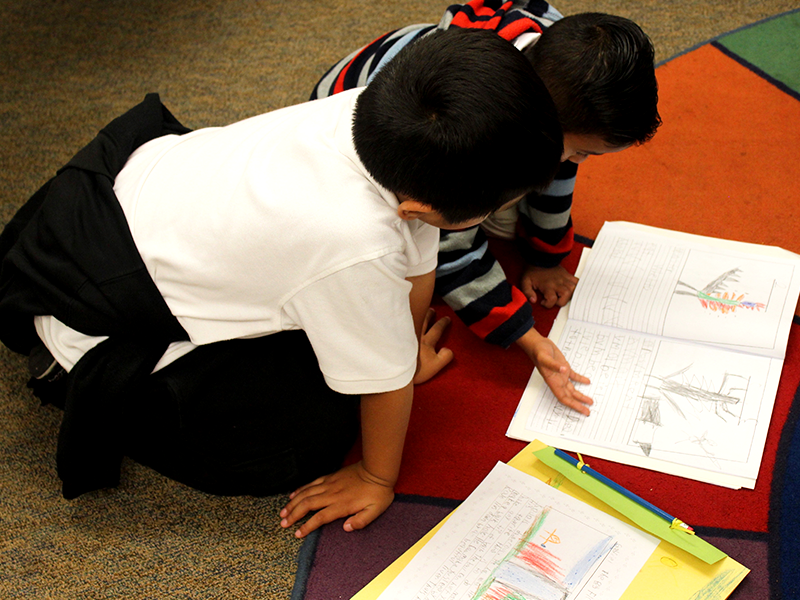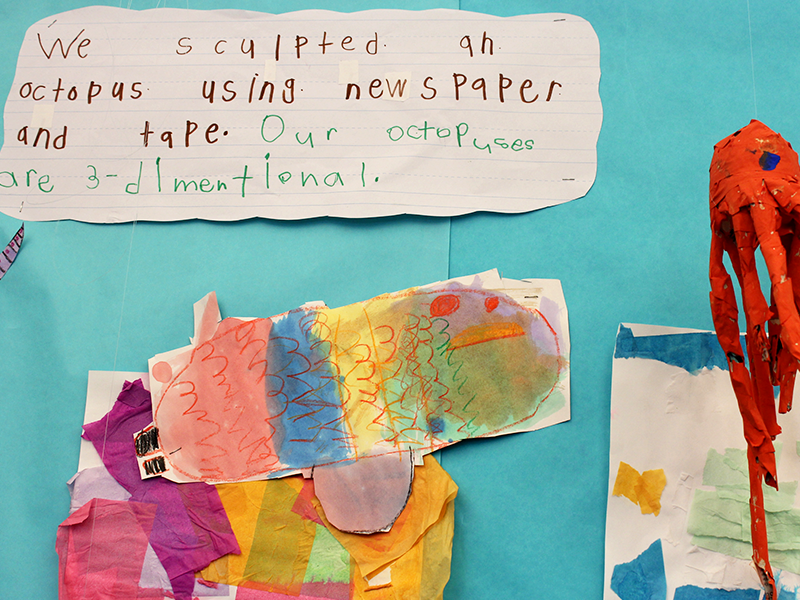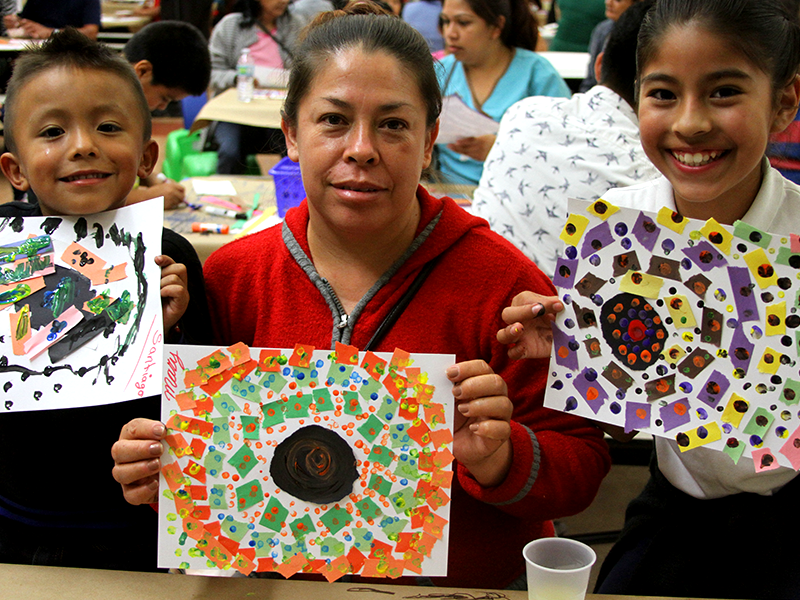With the Turnaround Arts: California Regional Coach Pilot Program (RCPP) in action at all of our 16 partner schools across the state, we are so grateful for the myriad of opportunities to work strategically, collectively, and collaboratively with organizations whose missions and methods are so aligned with our own. This month, we convened RCPP representatives from Alameda County Office of Education, Integrated Learning Department, Collaborations: Teachers and Artists (CoTA), North Coast Arts Integration Project, Orange County Department of Education, P.S. ARTS, and Sunset Center to reflect on where we’ve been as a learning community, what our school sites need most heading into the last few months of this school year, and how we can refine our practice in the weeks to come.
We recently interviewed Program Director Danielle Reo and Lead Artist Reneé Weissenburger from CoTA, which provides regional coaching at Burbank Elementary School (San Diego), about their experiences in the RCPP thus far.
What is CoTA, and how did its partnership with Turnaround Arts: California begin?
Collaborations: Teachers and Artists (CoTA) is a nonprofit, professional development organization that tackles the possibilities of making the arts a lively, essential, and ongoing aspect of elementary school education. Since its inception in 1998, CoTA has collaborated with 1,200 teachers and more than 25,000 students at 41 schools from six districts across San Diego county. CoTA maintains a core belief that integrating the visual and performing arts into academic content fosters critical and creative thinking, collaborative learning, subject matter relevancy, empathy for others, and a love of learning for all students. Fundamental to CoTA’s mission is a commitment to deep, long-term work with classroom teachers to facilitate a shift in instructional practice resulting in competencies that ensure sustained, ongoing changes in pedagogy.
Since inception, we have guided teachers in deploying the arts as modes of inquiry and expression, creating an efficient framework for collaborative planning and reflection, and providing strategies that support student learning. Through backwards design and hand-tailored lessons, CoTA artist/teacher teams carefully craft arts-based projects to meet specific learning goals of individual classes. Working with whole schools, CoTA’s work is focused on building the capacity of classroom teachers through a model of gradual release of responsibility over the course of three years. Whole school workshops and project wrap-up meetings involving the entire staff at key points in time complement the individual work with teachers.
CoTA administrators and artists alike were thrilled to be invited to submit a proposal to partner with Turnaround Arts: California at Luther Burbank Elementary School in San Diego. CoTA’s relationship with principal Rachel Messineo and Burbank teachers and students began in spring 2014, towards the end of Burbank’s first year as a Turnaround Arts: California partner school. Our arts-integration work augmented the arts programs that Turnaround Arts: California helped establish at the school, including the weekly 45-minutes of discrete arts instruction for all students and arts-based professional development for staff. During our first full year at Burbank, CoTA artists worked with 16 of 18 teachers to design and realize arts-integrated projects that supported student learning in science and English language arts. In spring 2015, Burbank received funding from the San Diego Unified School District for arts-integration under the Title 1 Learning Through the Arts program. The CoTA model was modified to meet the specific requirements of the program, and our work since then has focused on transitional kindergarten, kindergarten, and first grade.

Tell us about your role(s) as part of the Turnaround Arts: California Regional Coach Pilot Program.
Partnering with Turnaround Arts: California was a natural and symbiotic fit. We both believe that the arts can positively impact how students learn and educators teach. Our approaches to transforming elementary education are complementary. Whereas Turnaround Arts: California works with school administrators and staff to establish systems and structures that support ongoing arts instruction and access for all students, CoTA works with individual teachers to incorporate arts-based strategies to enhance learning for individual students. The arts provide multiple access points for students to connect with academic content and offer alternative ways for students to demonstrate understanding and application of what they are learning.
Our work as a Turnaround Arts: California RCPP partner has been rewarding over the course of this past year. We are working closely with Burbank’s principal and the Arts Leadership Team (ALT) to refine and monitor their Strategic Arts Plan goals, design protocols and tools to help staff meet their objectives, create opportunities to enhance parent engagement, connect the school to area arts resources, and showcase and archive their arts programs.
Equally exciting to us has been the development of relationships with the other RCPP partner organizations and representatives, and the work we are doing as a team with Turnaround Arts: California staff. Each of the Regional Coaches provides a great deal of experience, knowledge, and expertise. CoTA has been learning a tremendous amount about how we can deepen our impact at individual school sites and in the community. We are eager to see how the work that has been accomplished this year will shape the future of the RCPP and how CoTA will integrate our learning in the refining of our program approach and offerings.

What role do you see the arts playing in affecting change in the school community you are working with this school year?
There is no greater disadvantage to obtaining a quality education than that of a child who has lost confidence and interest. While we strive to reach all children, we are especially conscious of the need to employ creative strategies to engage and elevate students who struggle within the traditional confines of our education system. Because learning is not one-size-fits-all, and standardized approaches rarely demonstrate a conclusive assessment of knowledge and comprehension of students across the board, we strive to tap into multiple intelligences and offer alternative means of communication. The arts as a standalone activity or as an instructional approach are positioned to uniquely address the needs of our state’s students, especially English language learners, visual learners, and kinesthetic learners. When struggling students are offered various ways to demonstrate their knowledge and comprehension, confidence rises, enthusiasm for learning becomes contagious, and improvement is validated both academically (retention of information, commitment to learning) and socially (empathy, collaborative learning).

Are there any events or projects you are particularly excited about this year?
We are pleased to be offering a six-week, artist-led parent class this spring. Parents will have the opportunity to connect, converse, and experiment with a variety of visual and performing arts activities that they can use at home to support their child’s learning in reading, science, and math. We aim to create supportive spaces for children to engage in a variety of learning styles, take creative risks, and ask critical questions both at school and at home. As parents discover creative ways to engage in their child’s learning, we invite them to evaluate and share their strategies with each other. This spring, we are also working with transitional kindergarten and kindergarten teachers to provide several art events around the “Raise the Reader” program they have been implementing.
Finally, we are excited about the July Celebration of Learning. Together with the ALT team, we will be installing an exhibition showcasing recent arts-integration student work completed under the guidance of teachers, arts specialists, and CoTA artist/teacher teams. The exhibition will not only highlight the artistic development of the students — it will also demonstrate how the arts can be used to support student learning of academic content.
